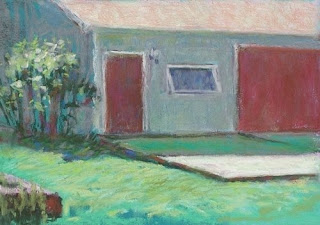I recently had a question from a reader who is making the switch from acrylics to oils. What's bothering him is the longer drying time of oils.
I used to paint in acrylics. At the time, I was living in the Southwest, and as one can imagine, acrylics dry pretty quickly out there. I found myself doing everything I could to keep the paint wet and workable. Eventually, a light bulb clicked on, and I realized that I was trying to make them act like oils. Why not go with the genuine article? I thought, and so I switched. I haven't looked back since.
Even so, as my reader notes, the slower drying time can be a problem.
 "Yellow Barn, Evening"
"Yellow Barn, Evening"
6x8 oil, en plein air - SOLD
It's a plus if you're painting portraits or large studio landscapes in which the paint must stay workable so you can make adjustments day to day. But it's lousy for a plein air painter who needs to ship a piece not long after signing his name to it.
Oils can have a variety of drying times, depending on many factors. Key is heat. Since they dry by a chemical reaction (oxidation), the warmer they are, the faster they dry. Low humidity is also said to help, but in my experience in the oft-humid Canadian Maritimes, I haven't seen high humidity slow the drying time.
Another factor is pigment. For example, Zinc White takes much longer to dry than Titanium White. It can take days or weeks. Earlier in the year, when I was painting apple trees in full bloom, I found an old tube of Zinc White in a drawer -- it's not something I use typically -- and decided to give it a try. The apple blossoms took nearly two months to dry.
Alizarin Crimson also takes a long time. Other paints, such as earth colors like Burnt Sienna, dry very quickly.
Here's what to do if you want your paintings to dry in 24 hours or less.
First, you can use an alkyd paint rather than traditional oil paint. Alkyd is a resin, and it dries within hours. Since a great deal of white is used in outdoor painting, one might use alkyd white and make sure to mix a bit of it into everything. Winsor & Newton makes the
Griffin Alkyd line of paints, and their Titanium White would be a good one to try.
Another option is to use a fast-drying medium, such as Gamblin's
Galkyd Painting Medium or
Galkyd Lite. Thin layers of color put down with these will dry within 24 hours. Thicker paint, of course, takes a little longer. If you tend to use thick paint, try using alkyd white with them.
One last option, which is not often recommended, is to add a siccative or drier such as lead napthenate, cobalt drier or
CoZiCa. Driers can affect the stability of the paint film over time.
Finally, if you're painting
alla prima (all at once), you may find it difficult to lay down wet paint on top of wet paint. To do this takes practice. For those last layers, use a "loaded" brush and, holding it horizontally to the surface, drag it very lightly across. Just kiss the surface. This way, the paint will come off without disturbing the lower layers of paint. This is how I add finishing touches such as highlights and dark accents.
(Yes, I have tried drying wet paintings in a warm oven. It does work, but the fumes are nearly overpowering. And 9 out of 10 artists, including this one, recommend against it. Again, stability is the issue.)























